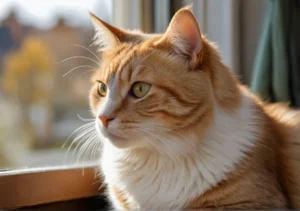Cats are known for their independence and curiosity, but why are some cats content to stay indoors? Let’s take a closer look at the reasons why many cat owners choose to keep their feline friends indoors.
Safety Concerns
Keeping your cat indoors can significantly reduce the potential dangers they may face outside. Traffic accidents are a real concern for outdoor cats, as they may not be aware of the dangers of passing cars. Predators such as coyotes or birds of prey pose a threat to outdoor cats, especially in rural areas. Exposure to diseases like feline leukemia virus or feline immunodeficiency virus is also more likely for outdoor cats due to contact with other animals.
Health Benefits
There are numerous health benefits to keeping your cat indoors. By staying inside, your furry friend is protected from parasites like fleas and ticks that can cause discomfort and even transmit diseases. Indoor cats also have a reduced risk of injuries from fights with other animals or accidents. Additionally, indoor cats are less likely to ingest toxic plants or substances that could harm them.
In addition to these benefits, keeping your cat indoors allows you to monitor their behavior and health more closely, helping you to detect any potential issues early on. By providing a stimulating indoor environment with plenty of toys, scratching posts, and cozy spots to nap, you can ensure that your cat remains happy and healthy indoors.
Environmental Impact
Indoor cats can help reduce their environmental impact on local wildlife and ecosystems. When cats roam outdoors, they can hunt birds, small mammals, and insects, disrupting the natural balance of the ecosystem. By keeping cats indoors, we can help protect vulnerable species and maintain the biodiversity of our environment. Additionally, outdoor cats can also spread diseases to wild animals, further threatening their populations. Therefore, by keeping cats indoors, we can play a role in preserving the delicate balance of nature.
Behavioral Considerations
Some cats may prefer to be indoors due to various behavioral reasons. For example, indoor cats may feel more secure and comfortable in familiar surroundings, reducing stress and anxiety that can arise from encountering unknown environments outdoors. Socialization issues or fear of unfamiliar surroundings can also contribute to a cat’s preference for indoor living. By providing stimulating toys, scratching posts, and interactive play sessions, we can help indoor cats stay mentally and physically active, fulfilling their behavioral needs in a safe and controlled environment.
Additional Unique Insight:
Health Benefits
Indoor cats are generally healthier than outdoor cats. They are less exposed to dangers such as traffic accidents, predators, and environmental hazards. By keeping cats indoors, we can help prevent injuries, infections, and other health issues that outdoor cats may encounter. Regular veterinary check-ups, proper nutrition, and a safe indoor environment can contribute to a cat’s overall well-being and longevity. Indoor cats are also less likely to contract parasites or diseases from interacting with other animals outdoors, further promoting their health and quality of life.
Enrichment Opportunities
Cats are innately curious and playful creatures, making it essential to provide them with ample enrichment opportunities to keep them mentally and physically stimulated indoors. Interactive toys are a great way to engage your feline friend, offering them hours of entertainment and exercise. Consider toys that mimic hunting behaviors, such as feather wands or kibble-dispensing puzzles to keep them engaged.
In addition to toys, scratching posts are vital for cats to fulfill their instinctual need to scratch and stretch. Opt for sturdy, tall scratching posts covered in sisal or cardboard to prevent damage to furniture. Cat trees with multiple levels and hiding spots can also provide mental stimulation, exercise, and a sense of security for your indoor cat.
Remember, regularly rotating toys and providing new challenges will prevent boredom and keep your cat active and engaged. Set aside dedicated playtime each day to bond with your furry companion and provide them with the mental and physical stimulation they need to thrive indoors.
Alternative Options
While indoor cats enjoy safety and protection from outdoor dangers, many cat owners want to provide their feline friends with a taste of the outdoors. Enclosed outdoor spaces, such as catios or enclosed porches, can offer a compromise by allowing cats to experience the sights, sounds, and smells of the outdoors in a controlled environment.
For those seeking more adventure, supervised outdoor excursions can provide cats with outdoor enrichment while ensuring their safety. Invest in a secure harness and leash to take your cat on leisurely walks in a quiet neighborhood or protected backyard. Training your cat to walk on a leash may take time and patience, but it can be a rewarding experience for both you and your feline companion.
Remember, safety should always be the top priority when considering outdoor options for your indoor cat. Stick to enclosed spaces or supervised outings to give your cat a taste of the outdoors without exposing them to potential risks. Supervision is key to ensuring your cat’s well-being while enjoying the benefits of outdoor exploration.
Community Regulations
If you’re wondering why more and more people are choosing to keep their cats indoors, one significant factor to consider is community regulations. Many cities and neighborhoods have ordinances or regulations in place that restrict cats from roaming freely outdoors. These rules are often put in place to protect wildlife, reduce the spread of diseases, and prevent outdoor cats from becoming a nuisance to neighbors.
In urban areas, where traffic and other dangers are more prevalent, keeping cats indoors can help ensure their safety. Additionally, in residential neighborhoods, outdoor cats may face threats from predators, other animals, or even human harm. By adhering to these community regulations and keeping cats indoors, pet owners can help ensure the well-being of their feline companions while also being respectful neighbors.
Myths vs. Facts
Are you hesitant to keep your cat indoors because of common myths surrounding indoor cats? Let’s debunk some of these misconceptions and shed light on the facts. Contrary to popular belief, indoor cats can lead happy and healthy lives if provided with proper enrichment and stimulation.
Myth: Indoor cats are always unhappy and unhealthy compared to outdoor cats. Fact: With the right environment, indoor cats can be just as content and healthy as outdoor cats. Providing toys, scratching posts, climbing structures, and interactive play can keep indoor cats mentally and physically stimulated.
Myth: Indoor cats are more prone to obesity and behavioral issues. Fact: While indoor cats may be at a higher risk of obesity if not given enough exercise, proper diet management and engaging play can help prevent weight gain. Additionally, indoor cats are less likely to be exposed to infectious diseases and parasites commonly found outdoors.
Myth: Indoor cats miss out on the freedom of the outdoors. Fact: Indoor cats can still enjoy the outdoors safely through supervised outdoor time in enclosed spaces like catio or leash walks. These activities allow cats to experience the outdoors while ensuring their safety.
Cat Breeds and Indoor Living
When it comes to deciding whether your feline friend should be an indoor companion, it’s crucial to consider the specific breed of your cat. Different cat breeds have varying needs and preferences when it comes to living indoors versus outdoors. Breeds such as Siamese, Ragdoll, and Persian are known to be more suited for indoor living due to their docile nature and potential health issues that can arise from outdoor exposure. On the other hand, breeds like Maine Coon, Bengal, and Savannah are more adventurous and may thrive in outdoor environments. Understanding your cat’s breed characteristics can help you make an informed decision about their living arrangements.
Moreover, indoor cats generally live longer than outdoor cats due to the reduced risks of accidents, exposure to diseases, and encounters with predators. By providing a safe and enriching indoor environment, you can ensure your cat’s health and well-being for years to come.
If you’re unsure about your cat’s breed or have a mixed-breed cat, observing their behavior and consulting with your veterinarian can give you valuable insights into whether they would be better suited as an indoor cat.
Remember, every cat is unique, so it’s essential to consider their individual needs and personalities when making the decision about indoor versus outdoor living. By taking into account your cat’s breed characteristics and providing a safe and stimulating indoor environment, you can ensure a happy and healthy life for your feline companion.
Alex, a passionate animal lover, has experience in training and understanding animal behavior. As a proud pet parent to two dogs and three cats, he founded AnimalReport.net to share insights from animal experts and expand his knowledge of the animal kingdom.




